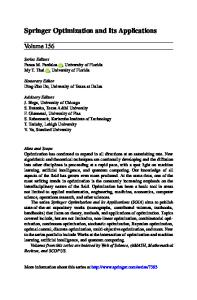Stochastic Systems Uncertainty Quantification and Propagation
Uncertainty is an inherent feature of both properties of physical systems and the inputs to these systems that needs to be quantified for cost effective and reliable designs. The states of these systems satisfy equations with random entries, referred to a
- PDF / 14,421,215 Bytes
- 533 Pages / 439.37 x 666.142 pts Page_size
- 28 Downloads / 658 Views
Series Editor Hoang Pham
For further volumes: http://www.springer.com/series/6917
Mircea Grigoriu
Stochastic Systems Uncertainty Quantification and Propagation
123
Mircea Grigoriu Cornell University Hollister Hall 14853 Ithaca NY, USA
ISSN 1614-7839 ISBN 978-1-4471-2326-2 DOI 10.1007/978-1-4471-2327-9
ISBN 978-1-4471-2327-9 (eBook)
Springer London Heidelberg New York Dordrecht British Library Cataloguing in Publication Data A catalogue record for this book is available from the British Library Library of Congress Control Number: 2011941678 Ó Springer-Verlag London Limited 2012 Apart from any fair dealing for the purposes of research or private study, or criticism or review, as permitted under the Copyright, Designs and Patents Act 1988, this publication may only be reproduced, stored or transmitted, in any form or by any means, with the prior permission in writing of the publishers, or in the case of reprographic reproduction in accordance with the terms of licenses issued by the Copyright Licensing Agency. Enquiries concerning reproduction outside those terms should be sent to the publishers. The use of registered names, trademarks, etc., in this publication does not imply, even in the absence of a specific statement, that such names are exempt from the relevant laws and regulations and therefore free for general use. The publisher makes no representation, express or implied, with regard to the accuracy of the information contained in this book and cannot accept any legal responsibility or liability for any errors or omissions that may be made. Printed on acid-free paper Springer is part of Springer Science+Business Media (www.springer.com)
To Betsy
Contents
1
Introduction . . . . . . 1.1 Introduction. . . 1.2 Organization . . 1.3 Classroom Use. References . . . . . . . .
. . . . .
. . . . .
. . . . .
. . . . .
. . . . .
. . . . .
. . . . .
. . . . .
. . . . .
. . . . .
. . . . .
. . . . .
. . . . .
. . . . .
. . . . .
. . . . .
. . . . .
. . . . .
. . . . .
. . . . .
. . . . .
. . . . .
. . . . .
. . . . .
. . . . .
. . . . .
. . . . .
. . . . .
. . . . .
. . . . .
. . . . .
. . . . .
. . . . .
. . . . .
1 1 5 6 7
2
Essentials of Probability Theory . . . . . . . . . . . . . . . . 2.1 Introduction. . . . . . . . . . . . . . . . . . . . . . . . . . . 2.2 Probability Space . . . . . . . . . . . . . . . . . . . . . . . 2.2.1 Sample Space . . . . . . . . . . . . . . . . . . . 2.2.2 r-Field . . . . . . . . . . . . . . . . . . . . . . . . 2.2.3 Probability Measure . . . . . . . . . . . . . . . 2.2.4 Construction of Probability Spaces. . . . . 2.3 Measurable Functions and Random Elements . . . 2.4 Independence. . . . . . . . . . . . . . . . . . . . . . . . . . 2.5 Sequence of Events . . . . . . . . . . . . . . . . . . . . . 2.6 Expectation . . . . . . . . . . . . . . . . . . . . . . . . . . . 2.7 Convergence of Sequences of Random Variables. 2.8 Radon–Nikodym Derivative . . . . . . . . . . . . . . . 2.9 Distribution and Density Functions . . . . . . . . . . 2.10 Charac
Data Loading...











